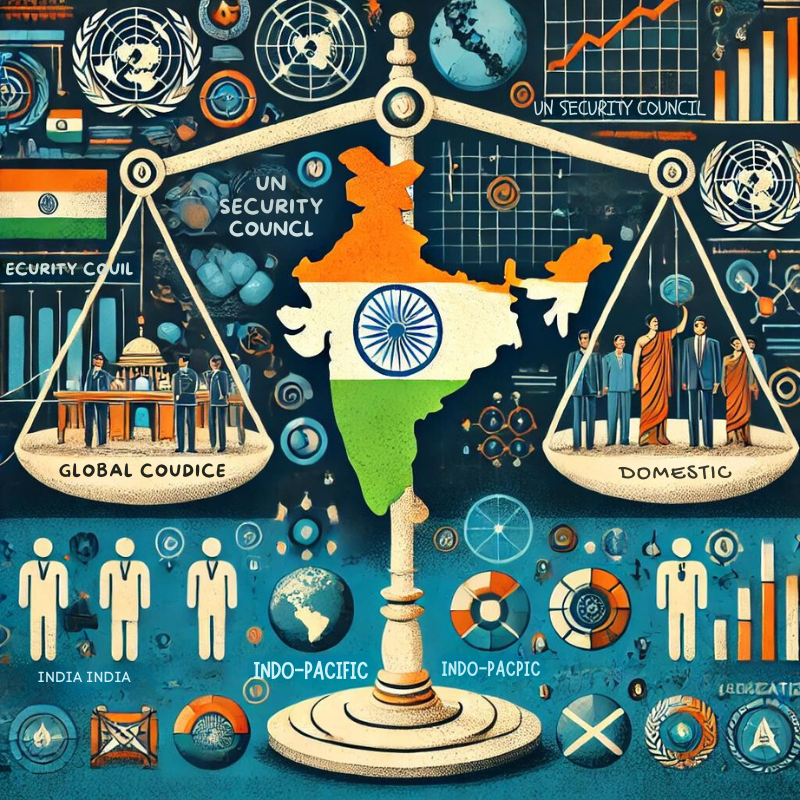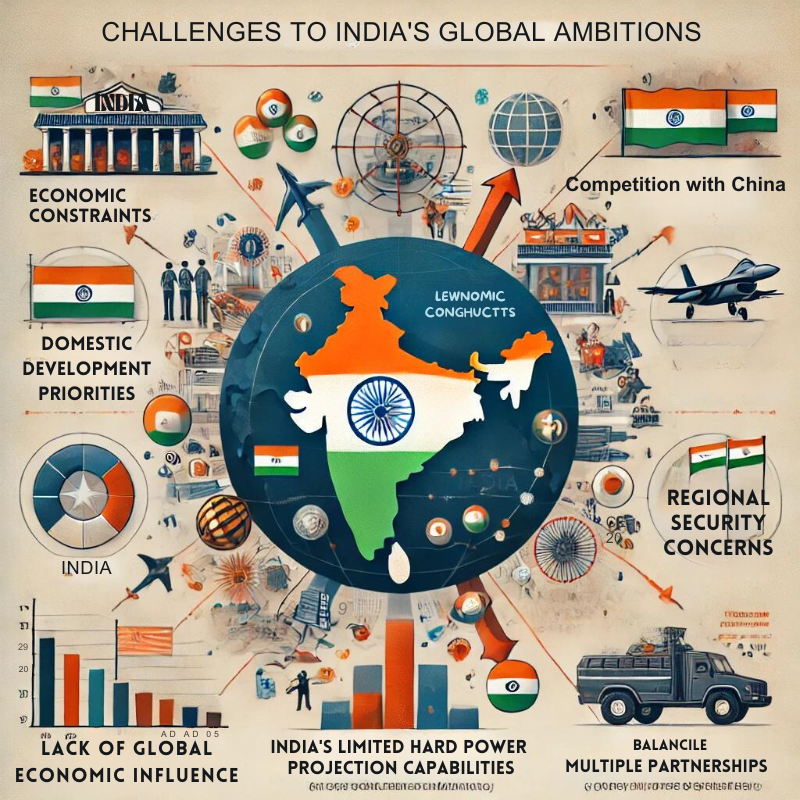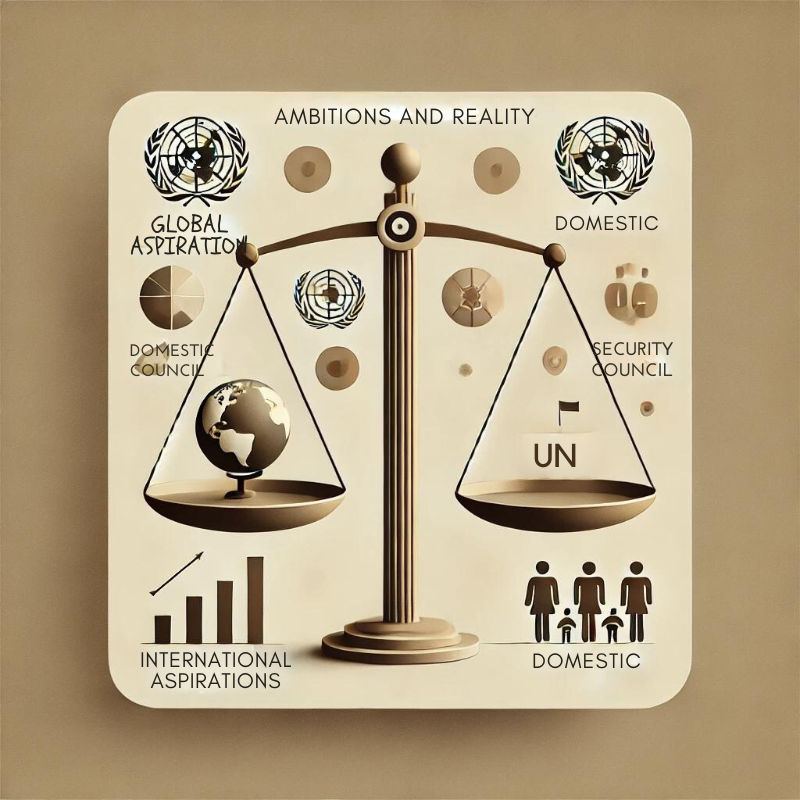India, the largest democracy and fifth-largest economy of the world, now stands at a crucial juncture in its journey toward making a mark globally. With its foreign policy strategy, India’s attempts to reconcile ostensible global aspirations with pressing, immediate domestic needs-what could be called the ‘dual mandate’ of foreign policy strategy-whilst continuing simultaneously to aspire to play a significant role on the global stage. It has to solve the problems of poverty and inequality first at home. India wants to assert itself as a major global player and strive to get a permanent seat in the UNSC and expand its influence, especially in the Indo-Pacific region.
| GS Paper | GS Paper III |
| Topics for UPSC Prelims | UN Security Council (UNSC), World Bank, International Monetary Fund (IMF), Human Development Index, BRICS , 2+2 Ministerial Dialogue, Make in India, Digital India, Quad, I2U2, The Indo-Pacific Economic Framework (IPEF), The India-Middle East-Europe Economic Corridor (IMEC), 3rd Voice of Global South Summit, COP28, Green Credit Initiative, Special Drawing Rights, Agni-4, Chandrayaan-3 mission, SAARC |
| Topics for UPSC Mains | Significance of Indian Foreign Policy in Securing its National Interests. |
Origin of the Article
This editorial has been drawn from “Ambitions and Reality in Indian Diplomacy” published on Business Standard on 17/09/2024. This article summarizes that being a developing country, India being a $3.5 trillion economy standing at the fifth position globally, faces income inequality at a staggering level. It holds vast potential with India being the world’s fastest-growing major economy and having the biggest population.
Relevance for UPSC Aspirants
Understanding the balance between India’s global aspirations and domestic needs helps UPSC students get better about the issues confronted by them. It falls under UPSC syllabus International Relations and Governance and helps understand the complexity of India’s foreign policy, economic strategies, and domestic challenges.
Why in News?
The strategy of foreign policy stands under the prism as the country seeks to find a balance between realizing global ambitions and satisfying domestic needs, a relevant topic for UPSC aspirants. This issue resonates well with previously asked questions on India’s international status and its developmental problems. Understanding the balance would make aspirants mention that India’s foreign policy accommodates complexities and their implications on national growth as well as global influence.

Ambitions and Reality in Indian Diplomacy
While Indian diplomacy bolsters global ambitions from one side, it tries to balance them against regional challenges. It seeks greater influence on the world stage but must temper these ambitions in the face of geopolitical tensions, economic constraints, and complex alliances. These all force strategic adjustments in practice.
India’s Global Ambitions
India-the ambitious developing country seeks greater claims to its space on the world map, hoping to gain increased influence and a more notable positioning in the map of world. This will be an enduring member of the UN Security Council and gain significant influence within the Indo-Pacific region.
Permanent Membership in the UN Security Council
India’s aspiration for permanent membership of the UN Security Council is, on the one hand, an expression of its newly emerged global status; on the other hand, there is a desire to play a greater role in international governance. Such aspirations, however, will face stiff geopolitical resistance, reform complications, and opposition from the current permanent members, which add to its hurdles.
Economic and Strategic Influence in the Indo-Pacific
Building its ambition in the Indo-Pacific region on a firmer footing requires deepening economic and strategic influence to change the dynamics of power in the region. This is challenging: aspirational efforts have to be balanced with geopolitical challenges, meager resources, and complex regional alliances. The diplomatic game in India aims at heightening collaboration efforts amidst the highly competitive and dynamic landscape.
Leadership among Developing Economies
India aspires to become a leader among developing nations, seeing these developments in economic strength, strategic partnership, and diplomatic importance. However, truth teaches lessons on how regional disputes over resources and weighing out asymmetry in power can endow the world with unpredictable behavior on the part of aspiring leaders being India itself.
Dealing with Transnational Issues
It aspires to address transnational challenges, such as climate change, terrorism, economic instability, especially through the search for global leadership in multilateral frameworks. Of course, though, such high-flying aspirations are always tempered by domestic needs, power equations, geopolitical considerations, and shifting trends in global power equilibriums that mandate pragmatic strategic adjustments in the conduct of international relations.
Representation in International Financial Institutions
International Financial Institutions India’s aspirations lie in seeking influence in international financial institutions that corresponds to its economic growth. In reality, India has no heavy representation or say in the decision-making process. In addition, though India is a vocal advocate of reform of such institutions like IMF and World Bank, India’s influence is still restrained by aging structures of governance.
Military and Technological Advancements
The military and technological prowess of India really fuels its ambitions as a global power to be safe. Although India wants to be a superpower in defense and technology, it is mostly deterred by realities such as budgetary constraints, regional conflict, and dependence on foreign technology.
Soft Power Increase
India has been looking to create its soft power through culture, diplomacy, and extensive engagement around the globe in recent years. While an endeavor such as yoga diplomacy or Bollywood or development aid does function as a component of India’s image around the world, all that is not real because the regional conflicts, economic restrictions, and global competition shape the reality of testing the strategies of its soft power.

Challenges to India’s Global Ambitions
Besides these, Indian global ambitions face a challenge due to its economic constraints, regional conflicts and global shifting alliances; strategic and internal building foundations needed to achieve such international influence and leadership.
Economic Constraints
The constraints of the economy and fiscal deficits, infrastructure gaps, and unevenness in India’s development appear to confine its international ambitions often, and this deters investments in international influence, military modernization, and global partnerships. This makes India accomplish strategic objectives only after overcoming the internal economic issues.
Domestic Development Priorities
India’s global ambitions are limited by critical development requirements at home. Poverty, developing infrastructure, and economic inequality, among other issues, require large amounts of attention and investment. The balancing act against internal threats posed by these challenges and the thirst for increased global influence introduces complexity in defining the international diplomatic makeup of India.
Lack of global economic influence
The wide gap in terms of infrastructure deficiency, huge income disparities, and sluggish industrial growth in India, despite its being a rapidly growing economy globally, severely restrict its influence in the global economy, which is the major drawback that does not let it take leading economic roles; hence, it hampers its negotiations with powerful economies of global trade and financial institutions.
Regional Security Concerns
Ongoing tensions with Pakistan and border disputes with China continue to divert the attention and strain India’s resources in global engagement. These concerns complicated India’s ambition for international status.
Competition with China
Under intense pressures of competition with China, India’s global ambition suffers. Trying to undermine its emerging economic disparities, militarily repressive power imbalances, and diplomatic competitions-trends all challenging it to hold ground over the increasingly ascendible ambitions and strategic initiatives of China, as a steadily rising global power.
India’s limited Hard Power Projection Capabilities
India’s modest hard power projection capabilities currently pose a stiff barrier to its global pretensions. While the economy holds much promise and the military is in the process of modernization, logistical constraints, second-rate infrastructure, and security deficits in its very neighbourhood severely restrict its ability to project military power beyond its immediate region, thereby beating down upon its aspirations for a larger global role.
Strategic Balancing Between Multiple Partnerships
India’s international agenda evidently necessitates a balancing act on strategic partnership balances involving the United States, Russia, and China. The relationship is stressful because there are conflicting interests, tension in global geopolitics, and the regions’ dynamics. This requires diplomacy, economic strength, and a careful balancing of national interests with the global realities.
Steps to Achieve India’s Global Ambitions
These actions on the part of India towards global ambitions are both in economic reforms, good political outreach, and advancements in the military. India has moved quite some ways over the recent years to realize its ambition of being a global power through strengthening strategic alliances, improving economic diplomacy, raising defense capabilities, and promoting soft power initiatives. They all herald making India an important player in the decision-making process of the world and make it a tone set for international relations.
Permanent Membership in the UN Security Council
It is easy to dream big in a global context, but it’s another thing entirely to do something about it. One of the steps was lobbying through diplomats and aligning with others who were strategically very helpful to India on its journey to reach the UN Security Council. Then, there were inputs towards UN peace-keeping and an appeal to assume the role of a responsible world power. This is an attempt at showing how much India wants to be a superpower in the governance and decision-making circles at an international level.
Economic Reforms and Initiatives
Economic reforms and initiatives, such as Make in India and Atmanirbhar Bharat, and liberalized policies on foreign direct investment have formed the cornerstone for India’s ambitious globalization vision. It focuses on enhancing manufacturing, promoting self-reliance, attracting foreign investment, and strengthening trade ties that help position India as a new, aggressive player on the international economic front.
Diplomatic Outreach
The Indian diplomatic initiative globally has been proved the need for it in fulfilling the ends it desired regarding influence worldwide. Strengthening regional partnerships, engaging international forums, improving trade relations, and defense cooperation are some of the ways through which India attempts to project itself as a global power. In this respect, this strategic diplomacy at play quells India’s desire to become a prime moulder of international policies and decisions.
Augmentation of Regional Influence
To acquire regional influence and attain its interest to project power at the global level, India has opened up closeness with neighboring countries through cooperation in trade, defense collaboration, and communication through diplomatic channels. Concepts that have been developed, such as Act East policy, improvement in infrastructure, and creating influence in forums at the regional level, have enhanced India’s ability to reinforce strategic means towards securing permanency and stability in the region.
Regional Leadership Among Developing Nations
India will strive to lead the developing world by intensifying South-South cooperation, calling for climate justice, and economic cooperation. The major key initiatives include giving support in global forums such as G20, trade partnership deepening, and further reforms of international institutions with equitable representation and increased power for developing countries.
Addressing Transitional Changes
India has taken pro-active measures to face transnational challenges, such as climate change, terrorism, and cyber threats, to reposition itself to meet its ambition in the world. International cooperation pursued through increased diplomatic ties is complemented by participation in international forums to enhance India’s position in addressing the complex issues of the globalized world and extend its influence.
Representation in International Financial Institutions
India has aggressively spearheaded calls for higher representation within international financial institutions, and for that matter, even reforming the IMF and the World Bank. Voting rights, global economic forums, and strategic alliances help India push forward in order to increase its leadership over global financial governance.
Military and Technological Advance
Underpinning India’s global ambitions, important strides in military and technological advancements would be there. Crucial investment into modernizing defense forces, developing indigenous technologies related to space, nuclear capacities, cybersecurity capabilities, besides defense partnerships.
PESTEL Analysis
| Political: India seeks a permanent seat on the UNSC to influence global governance, but faces opposition from entrenched powers. Regionally, tensions with Pakistan and China divert resources from global ambitions. Balancing relationships with the U.S., Russia, and China challenges India’s strategic autonomy while managing regional and international priorities. Economic: Despite being the fifth-largest economy, India’s low per capita income and HDI ranking reveal significant internal disparities. Initiatives like “Make in India” aim to boost economic growth, but poverty alleviation and job creation remain pressing needs. India’s global economic influence remains limited compared to larger advanced economies like the U.S. and China. Social: India faces significant social challenges, including poverty, inequality, and limited healthcare access. These domestic issues often compete with its global ambitions. India’s soft power strategy, through initiatives like International Yoga Day and its diaspora, helps enhance its global image but must be balanced with improving social conditions at home. Technological: India’s advancements in space exploration, including missions like Chandrayaan-3, enhance its global standing, particularly in the Indo-Pacific. Digital initiatives like “Digital India” are transforming its economy. However, further investments in technological infrastructure and R&D are needed for India to compete with more developed global economies. Environmental: India is a leader in global sustainability efforts, with ambitious renewable energy targets and initiatives like the International Solar Alliance. However, balancing these international commitments with domestic growth, especially in energy-hungry industries, remains a challenge. Achieving sustainable development while supporting industrial growth is key to India’s environmental and economic future. Legal: India advocates for reforms in global institutions like the IMF and UNSC for greater representation of emerging economies. Domestically, while legal reforms support economic growth, judicial inefficiencies and regulatory barriers can hinder global investments. Streamlining legal processes is crucial to fostering innovation and strengthening India’s position on the world stage. |
The Way Forward
E conomic Foundations-Strengthening, technological innovation, and promoting strategic global partnerships- these are the bases and the direction to be taken by India to move forward. Sustained growth, regional stability, and diplomacy will take India through global challenges to long-term ambitions on the world stage.
Strengthening Domestic Foundations
Then, it would be important for India to continue developing its domestic foundation in consonance with the international aspirations. Improved internal challenges like poverty and infrastructure along with investments in technological innovation will help India strive for well-directed moves toward the international aspirations while sustaining stability at home.
Strategic Autonomy with Flexible Partnerships
India’s course for diplomacy remains on the path of strategic autonomy that accompanies the quest for malleable partnerships with global poles, as represented by the U.S., Russia, and China. National interests must balance the rapidly changing pragmatic geopolitical realities as it seeks independent decision-making to cooperate on issues of common concern to global power leaders and shares international issues for greater influence and more engaging supremacy in diplomatic rule.
Increase Diplomatic Capability
A high institutional capacity needs to be built if gaps between ambitions and realities have to be bridged in Indian diplomacy. Better regional and domestic knowledge, foreign service training, and suitable institutional architecture will make it easier for India to navigate complex global situations, engage in strategic negotiations, and claim its rightful influence upon the world stage.
Economic and Strategic Initiatives
Hence, the core of India’s economic and strategic initiatives must lie in furthering its diplomatic objectives. Of these, strengthening trade partnerships, enhancement of defense capabilities, and regional cooperation must be prioritized- the challenge being to reconcile this with the realities of the global world, like geopolitical tensions and constraints of resources for which one needs pragmatic adaptation for sustained diplomatic influence.
Conclusion of Global Challenges
Indian diplomacy in this world system has a role to play in balancing strategic partnerships, enrichment of soft power, and navigation of geopolitics complexities for strengthening economic resilience, fostering regional stability, and engaging multilateral forums and bringing India’s ambitions onto the path of global realities that ensure sustained influence on the international stage.
Building Regional Relationships
Regional relations are one of the areas that India needs to get the best balance of diplomatic aspiration and on-ground realities. Such strengthening of relationships will help India fortify its regional heft and, thereby, set a solid base for greater international diplomacy.
Reforming International Institutions
This is because India’s efforts to reform international institutions essentially express its ambition to get a fair deal in global governance. Changes that it advocates through the United Nations and other multilateral bodies are confronted with solidified power factors, whose revision is far more demanding on continuing diplomacy and coalitions.
| UPSC Civil Services Examination, Previous Year Questions (PYQs) Mains Q. Discuss the impediments India is facing in its pursuit of a permanent seat in the UN Security Council. (2015, GS Paper-II) Q. As India navigates the complexities of global geopolitics, its foreign policy must strike a balance between its economic ambitions and security concerns.” In light of this statement, evaluate the significance of India’s foreign policy in securing its national interests, particularly in relation to its engagements with multilateral organizations like the UNSC, BRICS, and the Global South. |


